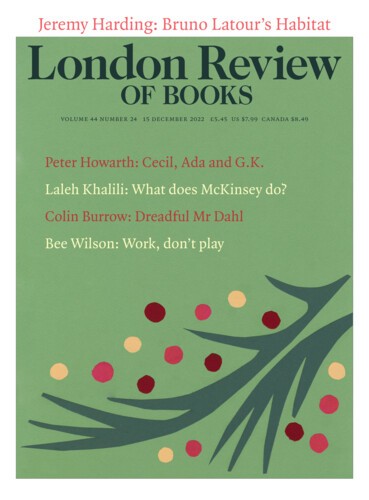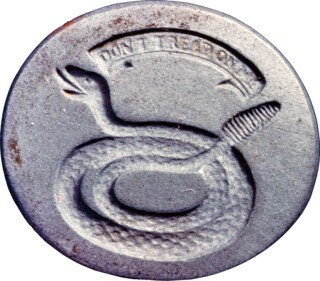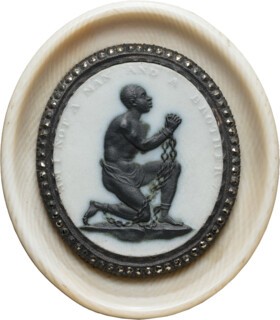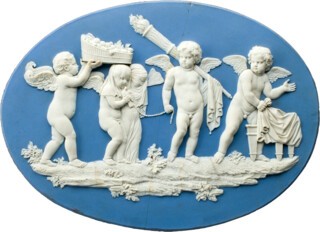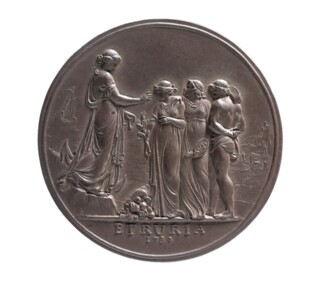In 1768, Josiah Wedgwood’s accountant reported an extraordinary event in his regular letter to the firm’s London offices. Among the details of invoices and updates on recent orders, he wrote that ‘Mr Wedgwood has this day had his leg taken off and is as well as can be expected after such an execution.’ Wedgwood was 38 years old and had suffered decades of pain precipitated by a childhood smallpox infection. His leg was sawn off without anaesthetic. A few days later, he suffered another blow: the death of his infant son, Richard. Although the wound healed well, the recovery would have been gruelling. All the while, the invoices and orders kept piling up. At the time of his surgery, Wedgwood styled himself ‘Potter to Her Majesty’ Queen Charlotte and was on the way to becoming one of the most famous manufacturers in Britain. He quickly began investigating the wooden prosthetics that would allow him to get back to work at his Staffordshire factory, resuming a life spent experimenting with ceramics, directing his workers and agents, forecasting trends and cultivating clients and political allies. His amputation would, he thought, ‘confute all those who deny the present to be an age of miracles’. A few years later, he referred to its anniversary as ‘St Amputation Day’.
Wedgwood didn’t want just to live in the age of miracles; he hoped to work miracles of his own. He was only partly joking when he declared his aim to become ‘Vase Maker General to the Universe’. He wanted to sell china to China, to school the French in fashion and to make monarchs and their subjects lust in equal measure after his products. He saw himself as motivated by the desire to cleanse the world of received wisdom, mindless tradition, corruption, superstition and waste, replacing them with principles of reason, efficiency, beauty and, of course, profit. After smallpox afflicted his knee in early adolescence, he could no longer use his leg to power a potter’s wheel, curtailing plans to follow his father’s profession. He began instead to imagine other careers, ones in which he might direct other people’s labour. Months of bed-rest also gave him access to a level of education he would otherwise have been denied. Did Wedgwood’s childhood illness fire his ambition? William Gladstone thought it was the making of him, turning his mind ‘inward’. Other early biographers insisted that his success was due to innate genius, rather than an accident of birth or circumstance. Tristram Hunt steers clear of hagiography, arguing that Wedgwood’s achievements were predicated on Britain’s burgeoning status as a colonial and imperial power, a nexus of global trade and industry. But shades of Wedgwood the singular genius remain. In Hunt’s telling, Wedgwood is both a product and a producer of his time: sometimes an opportunist and sometimes a creator, shaping the culture to suit his ambition.
In 1769, a year after losing his leg, Wedgwood separated the ‘useful’ branch of his business – the day-to-day tableware – from the ‘ornamental’, building a new factory to produce vases and objets d’art. He called the factory Etruria after the ancient Etruscan civilisation that was thought to be the source of many of the ancient vases being unearthed in Italy (they turned out to be Greek). ‘Etruscan’ vases and other excavations had fuelled a great enthusiasm for the material culture of classical antiquity, which Wedgwood and his business partner, Thomas Bentley, expertly harnessed. Turning away from the more flamboyantly decorated styles in which he had previously worked, including teapots in the shape of cauliflowers, Wedgwood began to emulate ancient vases, cameos and sarcophagi. He raided archaeological publications for design inspiration and employed artists, including those from the Royal Academy’s schools, to make models that were then refined, cast and produced in bulk at Etruria.
At the same time, Wedgwood and Bentley lobbied for the construction of the Trent and Mersey canal, which would allow them to transport their wares safely from Staffordshire to customers across Britain and, via the port of Liverpool, the whole world. They established a fashionable showroom in London and sold their finest wares to the rich and influential, often at a loss, to drum up middle-class demand for cheaper and more profitable lines. They were among the first manufacturers to produce detailed, pseudo-academic catalogues, to brand their products with their own ‘Wedgwood & Bentley’ stamp and to insist on standardisation, so that customers placing orders would know what they were getting. Through the division of labour, Wedgwood tried to ‘make such Machines of the Men as cannot Err’. Each artisan concentrated on a specialised, repeated task, overseen by new systems of industrial time discipline and cost accounting. Hunt draws attention to the ‘human cost and exploitative labour relations’ that lay behind the smooth surfaces of Wedgwood’s wares, but notes that he also built decent housing for his workers and invested in sanitation and education. Wedgwood saw himself as a compassionate moderniser, whose belief in the potential for optimisation, for wringing every drop of productivity out of his workers, dovetailed with the desire to improve their standard of living.
Wedgwood’s name still conjures up for many an image of his most popular invention, blue ‘jasper’: a pale cerulean ceramic ground against which classical motifs – a cherub here, a maiden there – are delicately picked out in crisp white relief. Jasper was an unglazed white stoneware that could be stained with mineral oxides, producing its distinctive colours: alongside various shades of blue, there was sage green, lilac and chocolate brown, all as matte, smooth and tactile as fondant icing. As well as vases of every shape and size, Wedgwood produced portrait medallions and chimneypiece tablets, buttons and buckles, teapots, inkwells, boxes and even chess sets in jasper. Thousands of experiments were performed to perfect it, many by Wedgwood himself who tested infinitesimal variations of raw materials and firing techniques. But jasper was only the culmination of a lifetime spent developing new compositions and glazes, from pearlescent creamware (called ‘Queensware’ after Queen Charlotte bought a table service) to black ‘basalt’, which was matte and sooty as a lump of coal and often painted with red figures in imitation of ancient vases. Wedgwood was always trying to make his vases seem ‘un-pot-like’, to lift them out of the earthy associations of clay and make them seem worthy of the prices he wanted to charge.
In creating jasper Wedgwood oversaw one of the most important advances in ceramics since the invention of porcelain around a thousand years earlier. Yet he never made porcelain itself, the translucent, delicate, durable ceramic body whose secret recipe had been sought by alchemists, potters and kings across 17th-century Europe. This was partly pragmatic – porcelain had proven unprofitable for other manufacturers and was bound up with complex patent legislation in Britain – but it also tells us something about Wedgwood: he wanted to produce something that was distinctively his, not simply a cheaper domestic version of prized foreign imports. Taking a different tack to other European manufactories, he attempted to make products that would displace porcelain in the public’s affections and that proudly announced their own novelty of composition and design.
In 1793, several of Wedgwood’s vases found their way back to the home of porcelain: China. They were brought there by the diplomat George Macartney, whose mission, under the guise of paying homage, was apparently to establish permanent diplomatic connections and persuade the Qianlong emperor to open up China to trade. Wedgwood’s vases were among a trove of objects Macartney took with him as evidence of the inventiveness of British design and technology. Hunt notes the ‘outrageous’ British hubris illustrated by this episode; the emperor was not tempted by the baubles on offer, nor by the prospect of losing control of his borders. But if Wedgwood never conquered China itself, his products successfully competed with Chinese porcelain and found favour both within and beyond the growing British Empire. Wedgwood wares were shipped across the globe, from Paris to St Petersburg, from the East to the West Indies, and from the Ottoman Empire to colonial Brazil.
Subsequent generations have often looked for their own equivalents to Wedgwood, seeking him as an origin point for their preferred model of capitalism. In 2004, Brian Dolan’s biography called him ‘the first tycoon’, emphasising his entrepreneurial brilliance and rags-to-riches narrative. The epilogue to the American edition quoted Donald Trump, who claimed Wedgwood would have been honoured to be described as a tycoon. (This might say more about the publishers’ desire for a good quote than it does about Trump’s interest in jasperware.) Hunt offers an analogy that probably fits his own preferences better: Steve Jobs. For Hunt, Wedgwood – like Jobs – was a ‘defining figure’ of an age, whose work had an impact on people’s lives even when they couldn’t afford his products. This is the entrepreneur not as tycoon but as creative visionary, who reinvents an industry, unites aesthetic and technological innovation, and builds a universally recognisable brand. One might also, of course, draw less flattering parallels between both brands’ dependence on cheap labour and problematically globalised markets.
The book’s main argument, though, is more historically specific: it presents Wedgwood as a ‘radical potter’, not just in his ceramic innovations but also in his politics. It’s true that Wedgwood was a religious non-conformist, a Dissenter who supported the American and French Revolutions, was committed to the abolition of slavery, and believed in both parliamentary reform and the education of women. He shared these inclinations with most of his closest friends, especially Bentley and his fellow ‘Lunar Men’: the select club of Midlanders that included Joseph Priestley, James Watt and Erasmus Darwin.
But many of Wedgwood’s more radical ideals were in direct conflict with the needs of his business, which involved putting expensive, intricate ornamental vases on royal and aristocratic tables to stimulate emulative demand among the ‘middling sort’. In business, as Wedgwood reminded Bentley in 1771, he preferred to ‘begin at the Head first, and then proceed to the inferior members’ of the body politic, even if in private he was questioning monarchical oppression. He railed against the injustices visited on American colonists by the British government and quietly produced a seal in support of the Revolution – a rattlesnake bearing the motto ‘Don’t Tread on Me.’ But he warned Bentley that such ‘unchristian’ objects should be kept ‘for Private Trade’, especially given Queen Charlotte’s importance as a patron of his brand.
While the revolutionary rattlesnake was hidden from public view, Wedgwood’s abolitionist medallion became one of the defining images of the campaign to end slavery and is still one of the best known. It shows a kneeling Black man in shackles, naked except for a loincloth, raising his hands and eyes upwards in a gesture of supplication. Inscribed around the upper curve of the medallion is his question to an implicitly white viewer: ‘Am I Not a Man and a Brother?’ Based on the seal for the Society for Effecting the Abolition of the Slave Trade, on whose committee Wedgwood served, the medallion was widely distributed among members and sympathisers. Benjamin Franklin believed it would have a persuasive power equal to that of ‘the best written Pamphlet’. Thanks to its small size, it became a style statement, inset into jewellery, hair pins, shoe buckles and snuffboxes. According to the abolitionist Thomas Clarkson, it represented a moment when ‘fashion, which usually confines itself to worthless things, was seen for once in the honourable office of promoting the cause of justice, humanity and freedom.’
Wedgwood seems to have thrown himself behind the cause of abolition out of genuine conviction. The medallion presented a marketing opportunity of sorts, but he manufactured it in large numbers at his own cost and ran the risk of alienating wealthy customers who opposed abolition. At the same time, as Hunt acknowledges, Wedgwood’s business was inextricable from the socioeconomic structures that sustained the slave trade. He depended on secure colonial shipping routes and sold extensively to the American colonies: Boston and Kingston were the perfect place to offload wares that had passed the peak of fashion back in Britain. Closer to home, many of his British customers derived their fortunes, one way or another, from colonial trade, including the trade in human beings. This trade helped to fuel the boom in domestic consumption that allowed Wedgwood to dream of selling high-quality artistic tableware to a growing middle-class market. Colonial commodities such as coffee, tea and sugar, with their accompanying social rituals, provided the raison d’être for many of Wedgwood’s most successful products.
Like many who shared his ideals, Wedgwood abhorred plantation slavery while celebrating the foundation of new colonies, lauding their ‘civilising’ mission and their potential for catalysing new scientific discoveries. It was Wedgwood who analysed the clays sent back from Sydney Cove in New South Wales in 1788, when the first British settlement in Australia was established. Alongside his scientific investigations, Wedgwood used the clay to manufacture a medallion, designed by his best modellers. In this classicised allegory of colonial success, Hope, a young woman in flowing robes, reaches out to Peace with her olive branch, Art with her palette, and Labour, with a sledgehammer over his shoulder. A ship in the background shows the arrival of the colonists while a horn of plenty spills its contents onto the earth, as if to will it into productivity. Wedgwood described the scene as ‘Hope encouraging Art and Labour under the influence of Peace, to pursue the employment necessary to give security and happiness to an infant settlement’. The fact that other people had a prior claim to the land, and to the local clay, had no place in his picture.
On the back of the medallion, Wedgwood staked his claim to the new creation: ‘Made by Josiah Wedgwood of Clay from Sydney Cove’. On the front, instead of the name of the new settlement, the word ‘Etruria’ appears in large letters. Was New South Wales to become a revived version of ancient Etruria, the home of hard-working, unpretentious farmers and potters? Or did Wedgwood imagine the colony as a version of his factory, which brought forth beauty and profit from the Staffordshire land and the hands of its workers? In 1794 an article in the Gentleman’s Magazine would describe the factory in explicitly colonial terms, linking settlement abroad with the changes wrought by industry on England: Etruria was ‘a colony newly raised in a desert, where clay-built man subsists on clay’.
Back at Sydney Cove, Governor Arthur Phillip was delighted to receive his copies of Wedgwood’s medallion, which ‘showed the world that our Welsh clay is capable of receiving an Eligant impression’. Just as the clay pressed into Wedgwood’s mould had taken on the shape of a classical allegory, so too could the land of New South Wales be imprinted with the hallmarks of ‘civilisation’. In a poem to accompany the medallion, Erasmus Darwin imagined the colony’s landscapes as a blank canvas, ready to be populated with vistas of neoclassical buildings, canals, roads, arches, villas, farms, orchards, ‘tall spires and dome-capped towers’. Aboriginal peoples were of course written out, just as domestic factory workers were absent in Darwin’s visions of British industry and in Wedgwood’s presentation of his own products.
For Wedgwood, idealism and pragmatism were always in play and often in tension. As he wrote to Bentley early in their partnership, he was torn between the pursuit of profit and that of honour. The constant efforts to protect their products from counterfeiters and imitators were starting to feel grubby and rather exhausting: Wedgwood described them as ‘narrow, mercenary, selfish trammels – the coats of mail we are forging for our reluctant hearts’. Instead, he proposed substituting ‘fame’ and the public good as motives, allowing his factories to ‘make all the good, fine and new things we can’, rather than constantly trying to hinder copyists. If the manufactory grew famous and its proprietors seemed gentlemanly and magnanimous, the money would still roll in and perhaps in greater quantities.
Wedgwood was a visionary and a chancer, a disruptor and a paternalist, a civic-minded egotist and a social-climbing revolutionary. By the end of his life, he was a fellow of the Royal Society, his portrait had been painted by Joshua Reynolds, and his vases were displayed in the British Museum, along with many of the ancient originals that had inspired them. The Midlands were criss-crossed by canals he had helped build, while his ‘useful’ and ‘ornamental’ wares were found on royal tables across Europe. Alongside his factory, he had built a neoclassical mansion for his family to live in, Etruria Hall, which was depicted on one of the serving dishes he had made for Catherine the Great. The non-conforming, one-legged potter had made a place for himself in many of the most powerful and influential establishments in Britain. He had also overseen every detail of his sons’ education to ensure they would be well prepared to take over his business. In the end, they rejected the role, preferring the life of gentlemen that their father’s ‘mercenary’ pursuits had made possible.
Hunt tracks the decline of Wedgwood’s business after his death from jaw cancer in 1795. The company’s fortunes were revived in the 1940s after a new factory was constructed, but in the 1990s it was acquired and fatally mismanaged by a coalition led by Tony O’Reilly, who moved production offshore to Indonesia. After the business failed, the entire historic collection of the Wedgwood Museum was almost sold at auction, saved only by an international campaign in which Hunt took a leading role as the MP for Stoke-on-Trent. He is now director of the Victoria and Albert Museum, which acquired the collection in 2014, though it remains on display in Staffordshire. While the Wedgwood Museum has been saved for posterity, the business itself faces an uncertain future.
Wedgwood bequeathed more than his business to subsequent generations. His favourite daughter, Sukey, married Erasmus Darwin’s son Robert, and their son, Charles Darwin, imbibed his grandparents’ experimentalism and willingness to challenge convention. Darwin’s interest in evolution and inheritance may also have been influenced by his family’s health troubles. He married his first cousin, Emma Wedgwood, and wondered whether his children had suffered the consequences. In Josiah’s own generation, too, health was a constant concern. His wife, Sarah, was often ill, and their daughter Mary Ann died at the age of eight after years of fits, paralysis and blindness. Medical interventions must have made Mary Ann’s short life even less bearable: she was subjected to electric-shock therapy and her gums were lanced to treat teething (believed to be the cause of her convulsions). Perhaps Wedgwood found his unhappy proximity to the frailty of human flesh made easier by the process of perfecting his ceramic ‘bodies’, of pushing through innumerable trials to make them durable, reliable and reproducible. He wrote lovingly of the ‘infinite ductility of clay’, its ability to be simultaneously functional and beautiful. He modelled his own legacy in the portraits that he commissioned, none of which showed his wooden leg.
Send Letters To:
The Editor
London Review of Books,
28 Little Russell Street
London, WC1A 2HN
letters@lrb.co.uk
Please include name, address, and a telephone number.
